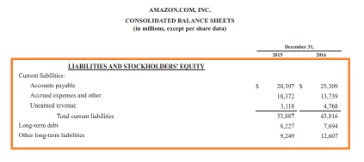Content

A responsibility to other parties that presupposes settlement by transfer or use of assets in future, provision of services or other transaction at a specified date or on demand. In its bankruptcy filing, the company listed liabilities of $363.7 million and assets of $141.3 million. Under the agreement, the insurance company has unlimited liability.
- Current liabilities are those that are payable within a year, and long-term liabilities are payable over a more extended period.
- Pitt asked the judge to absolve him from personal liability — to no avail.
- Current ones are due within one year and are typically paid for with current assets.
- A business’s assets may consist of buildings, machinery, equipment, patents, intellectual property, accounts receivable, and any interest owed to the business.
A type of borrowing from a bank or person to improve a business or personal income, which is payable at a predefined short or long period. Current liabilities are debts that need to be paid within a year – wages, for example. Liability Definition And Meaning The business has a liability as it owes money to the mortgage provider. To file an extension, taxpayers must have their name, address, Social Security number, estimated tax liability, and payment if one is owed.
More from Merriam-Webster on liability
The company accepts no liability for any loss, inconvenience, or delay caused by a cancellation of train services. Directors can incur personal liability for errors made by their companies. The https://kelleysbookkeeping.com/ government is planning to increase the tax liability on company cars. The transit agency wants to restrict future overtime and redirect funds used to pay down its employee pension liability.
What is the old definition of liability?
Previous definition of a liability
A present obligation of the entity arising from. past events, the settlement of which is expected. to result in an outflow from the entity of. resources embodying economic benefits.
Then, it can transfer the amount to the business’s revenue stream. Current liabilities are short-term debts that must be paid within the current cycle or one year. The liabilities component of the balance sheet helps businesses increase their value creation and organize business operations processes.
Are you looking to buy or sell properties? Check out the offerings on https://www.home-investors.net/illinois/investors-that-buy-houses-naperville-il/
Words nearby liability
Noncurrent are those due in more than one year and typically include any long-term debts the business has. Most businesses will record current and noncurrent liabilities in two line items on their balance sheet as an account of ongoing business operations. Long-term liabilities are those that will conclude in 12 months or more. While businesses usually pay for short-term liabilities with cash, they may pay for long-term ones with assets such as future earnings or financing transactions. Long-term ones typically consist of things like loans, bonds, rent, mortgage, taxes, payroll, and any employee pensions offered by the company. The most common liabilities are accounts payable and bonds payable.
- In contrast, the wine supplier considers the money it is owed to be an asset.
- A defect of title or undisclosed liability would invalidate the sale at any time.
- A liability is an obligation –like money, goods, or services– that you owe another party.
- In general, a liability is an obligation between one party and another not yet completed or paid for.
- Like businesses, an individual’s or household’s net worth is taken by balancing assets against liabilities.
- As a practical example of understanding a firm’s liabilities, let’s look at a historical example using AT&T’s balance sheet.
Assets are either things the business owns outright or are things that another party owes the business. Combining a business’s liabilities with its equities gives an accountant the business’s total assets. Liabilities mean the debt amount owed by a company to pay past transactions. A company may owe this payment to creditors, lenders, banks, or other financial institutions.